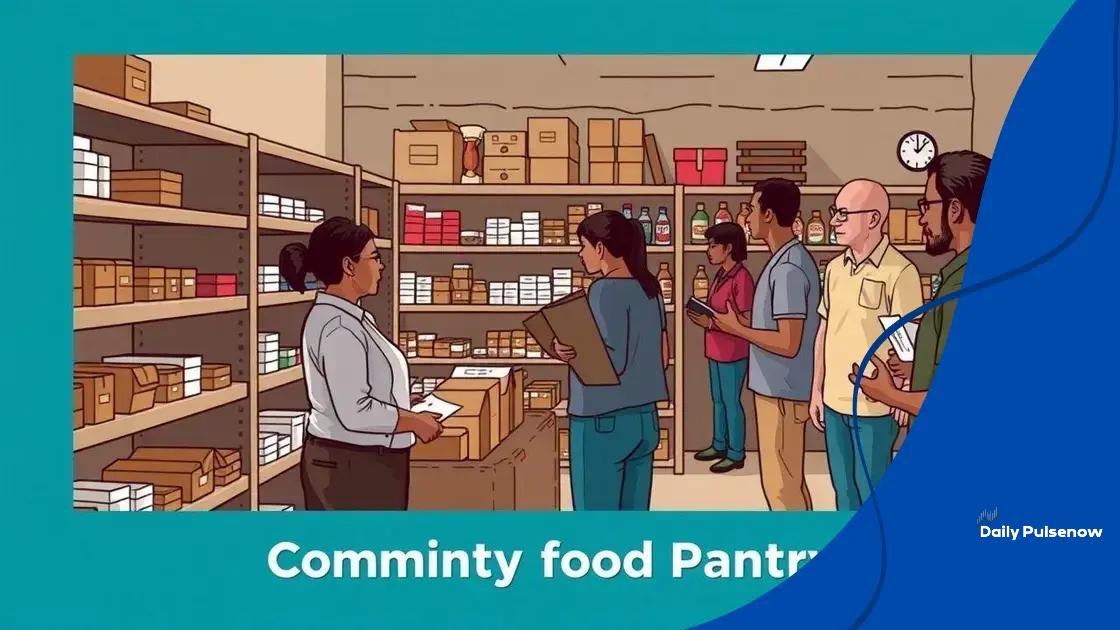Food assistance programs: innovations that make a difference

Anúncios
Food assistance programs provide vital resources to individuals facing hunger, using technology and community partnerships to improve access to nutritious food and support for families in need.
Food assistance programs play a crucial role in combating hunger in our communities. But have you ever wondered how these programs innovate and adapt to current challenges? Let’s dive into what’s new and what still needs attention.
Anúncios
Understanding food assistance programs
Understanding food assistance programs is essential in addressing hunger within communities. These programs provide vital resources to individuals and families facing financial difficulties. Knowing how these programs operate helps us appreciate their impact.
Key Types of Food Assistance Programs
There are several types of food assistance programs available to help those in need. Each program has its own specific eligibility requirements and benefits.
- Supplemental Nutrition Assistance Program (SNAP): This program offers food benefits to low-income individuals and families.
- Temporary Assistance for Needy Families (TANF): TANF provides financial assistance and food aid to families in need.
- Commodity Supplemental Food Program (CSFP): Designed for low-income seniors, this program distributes nutritious food packages.
- Women, Infants, and Children (WIC): WIC offers support to pregnant women, new mothers, and young children with healthy food options.
These programs not only supply food but also connect individuals with other essential services, creating a safety net for many families. Understanding their offerings can lead to better utilization and improvements in community welfare.
Anúncios
The Benefits of Food Assistance Programs
Food assistance programs help reduce food insecurity and improve health among participants. By providing nutritious food, these initiatives support healthy eating habits. They also enable families to allocate more resources toward other essential needs, such as housing and education.
It’s important to note that awareness and accessibility are key in allowing individuals to benefit from these services. Outreach efforts play a significant role in connecting those in need with available assistance. By informing communities about the programs, we can enhance participation and its positive outcomes.
Moreover, as the landscape of nutrition and food access continues to evolve, so do these programs. Innovation in service delivery, such as mobile pantries and online applications, has made it easier than ever for families to access help. By adapting to the changing needs of society, these programs remain vital in the fight against hunger.
Key innovations in food assistance
Key innovations in food assistance have emerged in response to changing needs in communities around the world. These advancements aim to improve the effectiveness and accessibility of programs. Understanding these innovations helps us see how food assistance is evolving.
Mobile Food Pantries
One significant innovation is the use of mobile food pantries. These trucks travel to underserved areas, bringing fresh produce and other food items directly to families who need them. Mobile pantries break down barriers related to transportation and distance, providing essential services right where people live.
- Increased Reach: They serve remote areas where traditional food pantries may not be accessible.
- Fresh Options: Mobile pantries often offer healthier options, such as fruits and vegetables.
- Community Engagement: These initiatives foster a sense of community involvement and support.
Innovations also include technology-enhanced programs. For example, many food assistance programs are now using apps to streamline the process of accessing food support. This technology allows for easier intake, letting users apply for benefits with just a few taps on their phones.
Online Ordering Systems
Online ordering systems provide another innovative solution. Many food banks now allow clients to order their groceries online for pickup or delivery. This flexibility helps improve client satisfaction and ensures they receive meals that align with their preferences and dietary needs.
Enhancements in food assistance have also extended to collaboration with local grocery stores and farms. Partnering with these entities allows assistance programs to offer a larger variety of food. Additionally, sourcing food locally supports the community and can reduce waste.
These innovations demonstrate that food assistance programs are not static; they evolve and adapt. As challenges arise, new solutions are developed to enhance food security and ensure that everyone has access to the nourishment they need.
Challenges faced by food assistance programs

Food assistance programs face several challenges that can hinder their effectiveness. Understanding these challenges is crucial for addressing food insecurity in communities. One significant issue is funding, as many programs rely on government support and charitable donations. When budgets tighten, the resources available to help families may be reduced.
Access and Awareness
Another challenge is access to food assistance. Many individuals who qualify for support may not be aware of the programs available to them. Outreach efforts must be strong to ensure that those in need know how to seek help.
- Lack of Information: Many eligible families do not receive the help they need due to a lack of information about available services.
- Transportation Issues: Some individuals cannot travel to food pantries or distribution sites, limiting their access to necessary resources.
- Stigma: The stigma associated with receiving food assistance can discourage people from seeking help.
Additionally, there are logistical issues that programs must navigate. Managing supply chains to ensure that food is fresh and available is a constant battle. This includes minimizing food waste while also meeting the diverse needs of participants.
Program Limitations
Many food assistance programs also have eligibility restrictions that can exclude some individuals in need. These limitations might be based on income or residency, leaving vulnerable populations without support. Furthermore, fluctuations in the economy can impact the effectiveness of these programs. As the economy changes, more individuals may find themselves in need of assistance, stretching already limited resources thin.
All these challenges highlight the necessity for ongoing evaluation and adaptation of food assistance programs. Engaging with community members and collecting feedback can help identify gaps and areas of improvement. By addressing these challenges, we can enhance the impact of food assistance programs and better support those experiencing hunger.
The role of technology in food support
The role of technology in food support has become increasingly important as communities strive to combat hunger. Innovations in tech are transforming how food assistance is distributed, making it more efficient and accessible. One of the most notable changes is the integration of digital platforms that connect people to resources quickly.
Mobile Applications
Mobile apps have emerged as a key tool in food assistance. These applications allow users to find food resources, apply for benefits, and receive updates on available programs right at their fingertips. This ease of access ensures that more individuals can seek the help they need without unnecessary barriers.
- Real-Time Information: Users can see what resources are available in their area.
- Application Support: Many apps provide step-by-step guidance for applying for food benefits.
- Notifications: Alerts can inform users about food distribution events and pantry hours.
Another technological advancement is the use of data analytics. Programs can analyze trends in food needs and tailor their services accordingly. By collecting data on who requires assistance and when, programs can optimize their operations to better serve communities.
Online Food Ordering
Online food ordering systems have also revolutionized food assistance. Many food banks now offer the option for clients to order groceries online, which can then be picked up or delivered. This innovation gives individuals more choice in the food they receive, ensuring it meets their dietary needs and preferences.
Apart from enhancing service, technology also plays a role in reducing food waste. By connecting food donors, such as restaurants and grocery stores, to food banks, surplus food can be distributed efficiently, helping those in need while minimizing waste. This connection promotes sustainability within communities.
With evolving challenges in food security, embracing technology offers numerous benefits. The innovations not only streamline assistance but also foster connections among different stakeholders in the food support system. As these tools continue to develop, they hold the potential to reshape how communities approach hunger and food resource allocation.
Success stories from communities
Success stories from communities illustrate the positive impact that food assistance programs can have on individuals and families. There are many inspiring examples of how these programs have transformed lives, providing not just food but also hope and support.
Community Partnerships
One community in Ohio developed a partnership between local farmers and food banks. This collaboration ensured that fresh produce was available to families in need. The program not only supplied nutritious food but also educated individuals on healthy eating and cooking. Workshops were organized, teaching families how to prepare meals using the fresh fruits and vegetables they received.
- Increased Access: Families gained consistent access to healthy options.
- Nutrition Education: Workshops helped improve cooking skills.
- Community Engagement: These events built stronger bonds among residents.
In another success story, a food pantry in California incorporated technology into their operations. They launched an online platform where clients could choose their groceries based on their preferences and dietary needs. This not only simplified the process but also empowered individuals to make healthier choices.
Empowering Individuals
Empowerment is a key theme in many success stories. For example, a group of women in Texas started a community garden funded by local grants. The garden provided fresh produce for their families and taught skills such as gardening and food preservation. This initiative fostered a sense of community and encouraged participants to take charge of their food sources.
These stories highlight that food assistance programs can go beyond merely providing food. They can create opportunities for education, community involvement, and personal growth. By celebrating these success stories, we can inspire other communities to develop their own programs and partnerships, promoting food security and resilience.
FAQ – Frequently Asked Questions about Food Assistance Programs
What are food assistance programs?
Food assistance programs provide support to individuals and families facing food insecurity, offering resources like groceries and meals.
How can I apply for food assistance?
You can apply for food assistance through local food banks, community organizations, or online platforms that facilitate access to these resources.
What types of food do assistance programs provide?
Programs often provide a variety of nutritious foods, including fresh produce, canned goods, and non-perishable items to meet diverse dietary needs.
How can technology improve food assistance programs?
Technology enhances food assistance programs by streamlining access, allowing online ordering, and using data analytics to better meet community needs.